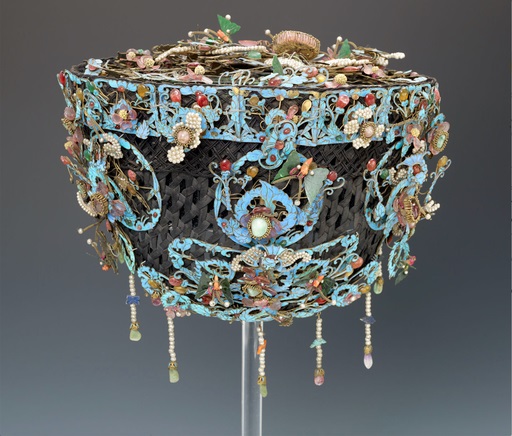
in Italiano / Italian translated by Chiara Ldln
This object has been translated into 9 different languages by 6 different users
Il copricapo Manchu o dian zi fu donato al Museo dalla signora Wood-Jones nel 1939. Ella fu la moglie di Frederic Wood-Jones FRS (1879-1954), uno dei fondatori della moderna antropologia fisica. Il suo lavoro portò la coppia in Inghilterra, Australia e Cina.
La decorazione è composta da pietre preziose, perle, coralli e smalti che rappresentano fiori, foglie e farfalle. Il colore blu deriva dalle piume intarsiate del martin pescatore che, durante la dinastia Qing, furono utilizzate esclusivamente dalla corte imperiale e dalle famiglie nobili.
Nel 1932-3 Frederic fu direttore temporaneo di anatomia al Peking Beijing Union Medical College. Si presume che il copricapo fosse stato acquisito in questo momento. Nel 1938 divenne professore di Anatomia all’Università di Manchester. Lui e sua moglie si stabilirono a Manchester e donarono le loro collezioni al museo. Questo copricapo fu indossato a corte da nobili donne, in occasioni speciali come matrimoni, cerimonie di compleanno e feste tradizionali. L’effetto finale del dian zi o ‘copricapo’ fu ulteriormente migliorato con l’inserimento di fiori e forcine.
La signora Wood-Jones donò al museo anche altri bellissimi accessori. Questi saranno in mostra nella nuova Galleria di Cultura Cinese Lee Kai Hung che aprirà nel 2022, parte della trasformazione Hello Future del museo di Manchester.
Do you have something you’d like to say, in your own language or English, about the object or translation? We’d like to hear what you think.
Translations are community-sourced and for anyone to participate in, however you use your language. For more information, see Community Guidelines.
20 Apr, 2023
Translation of this description (EN-ZH)
这件满族头饰又称钿子,于1939年由格特鲁德·伍德·琼斯夫人赠予曼彻斯特博物馆。她是弗里德里克·伍德·琼斯FRS(1879-1954)的妻子。弗里德里克·伍德·琼斯FRS是现代体质人类学的创始人之一。1932年到1933年,弗里德里克在北京协和医学院担任临时解剖学主任。这个头饰应该是在那个时候得到的。
1938年,弗里德里克·伍德·琼斯成为曼彻斯特大学解剖学主席。他和他的妻子定居在曼彻斯特,并将这顶头饰和其他私藏的物品捐给了博物馆。弗里德里克·伍德·琼斯还向曼彻斯特博物馆捐赠了一些其它美丽的配饰,与这顶头饰相配。
这顶头饰上的装饰包括宝石、珍珠、珊瑚和珐琅,代表鲜花、树叶和蝴蝶。蓝色来源于镶嵌的翠鸟羽毛,这种羽毛在清朝(1644-1912)仅供朝廷和富裕家庭使用。这种头饰通常是宫廷女子在大婚、庆祝诞辰和传统节日等特殊场合佩戴的。通过插入天然花朵和簪子,使得头饰的更加惊艳。
I found a similar Manchu headdress stored in The Palace Museum in Beijing. Here is its description and link to the website.
https://www.dpm.org.cn/collection/jewelry/231336.html
点翠钿子
点翠钿子,清,高17厘米,直径24厘米。清宫旧藏。帽胎以黑色丝绒缠绕铁丝编结而成,形似覆钵。由珍珠、珊瑚、玉石、碧玺等珠石组成各色花饰,点翠铺衬,铜镀金底托。花饰组成有吉庆祥瑞,有蝴蝶、连钱、仙鹤、灵芝、兰花、寿桃、如意、笔、葫芦、花篮、蜻蜓、天竺、石榴、祥云等,意寓子孙万代、长寿如意。钿子是清代妇女的头饰,穿戴时多与吉服相配。
(The Manchu headdress / Dianzi with Kingfisher ornaments
Dianzi with Kingfisher ornaments, from Qing dynasty (1644-1912), 17 centimeters tall and 24 centimeters in diameter, is stored in The Palace Museum in Beijing.
The hat felt, made of black velvet and braided with wire, is in the shape of bowl. It has coloful ornaments made by pearl, coral, jade, tourmaline and other gemstones, and is embellished with Kingfisher blue and copper gilt base. These coloful ornaments have auspicious connotations, including butterflies, glechoma, crane, ganoderma lucidum, orchid, Longevity Peach, Ru Yi, pen, gourd, flower basket, dragonfly, Tianzhu, pomegranate, auspicious cloud, meaning generations of children, longevity and good luck. It is a kind of Qing Dynasty woman’s headdress, often worn to match auspicious clothes.)